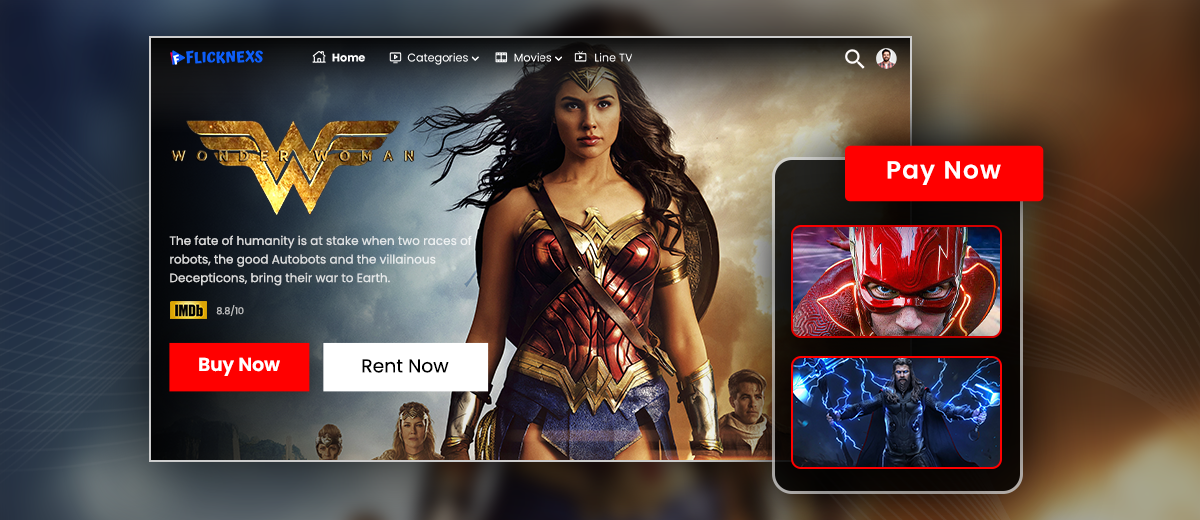In 2025, video monetization is evolving faster than ever. Creators, streamers, and businesses are looking for smarter ways to earn from their content beyond ads and subscriptions. One of the most powerful and profitable methods today is Pay Per View (PPV).
PPV allows audiences to pay a one-time fee for exclusive access to live streams, on-demand videos, or special events. It is a flexible model that gives creators complete control over pricing, branding, and viewer access while turning every view into real revenue.
In this guide, we will explore how Pay Per View works, how you can monetize your videos, and how to build your own PPV streaming platform with Flicknexs in 2025.
What Is Pay Per View (PPV)?
If you’ve ever paid to watch a boxing match, live concert, or exclusive online event, you’ve already experienced Pay Per View (PPV) in action. PPV is a video monetization model where viewers pay a one-time fee to access a specific piece of content—usually something exclusive, premium, or time-sensitive.
Unlike traditional TV subscriptions or free ad-supported platforms, PPV gives creators complete control over their content’s value. Instead of relying on ads or monthly fees, you charge viewers for direct access to your videos or live streams.
Why PPV Appeals to Creators
PPV gives you the freedom to set your own prices, manage access, and keep ownership of your work. It’s a fantastic way to:
- Monetize one-off events
- Test audience willingness to pay
- Build hype for premium experiences
- Diversify income streams alongside ad revenue or subscriptions
How Does Pay Per View Work?
While the concept is simple, the technology behind PPV ensures secure access, smooth streaming, and reliable payment processing.
Step-by-Step Process
- Upload or Schedule Your Video: The content is hosted on a secure platform like Flicknexs, which provides DRM (Digital Rights Management) protection.
- Set Your Price: You decide how much to charge per view—often ranging from $5 to $50 depending on exclusivity.
- Publish and Promote: The platform generates a unique event or video page you can share through your website, email list, or social media.
- Viewer Payment and Access: When a viewer pays, they instantly unlock streaming access for a fixed duration (e.g., 24 or 48 hours).
- Streaming Delivery: The video streams through a Content Delivery Network (CDN), ensuring smooth playback worldwide.
- Revenue Tracking: You can view analytics such as number of views, revenue per event, and viewer demographics.
Why the Technical Setup Matters
If your platform can’t handle large viewer volumes or secure payments, it can ruin the experience. That’s why reliable infrastructure like that provided by Flicknexs is critical for professional-level PPV streaming.
How Can You Monetize with Pay Per View?
There’s more than one way to make money with PPV. Let’s explore the strategies that successful creators use.
1. Fixed Pricing
This is the simplest method: set a single price for each event or video. For example:
- $10 for a live concert stream
- $20 for a 3-hour masterclass
- $5 for access to a short film
Fixed pricing works best when your audience clearly understands the value of what they’re buying.
2. Tiered Pricing
Offer multiple pricing options to attract a wider audience. For instance:
- Basic Ticket ($10): Live stream access only.
- Premium Ticket ($20): Includes replay access for 48 hours.
- VIP Ticket ($30): Adds exclusive behind-the-scenes content.
This method encourages fans to upgrade for more value.
3. Event Bundles
Combine multiple PPV videos into a discounted bundle. For example, a sports creator might sell access to an entire tournament instead of a single match.
4. Geo-Based Pricing
Adjust your prices based on location to make your content more accessible globally. Platforms like Flicknexs allow regional pricing control.
5. Hybrid Monetization
You can mix PPV with other revenue models such as SVOD (subscriptions) or AVOD (ads). For example, you might offer free teaser content (AVOD), a subscription plan for regular videos (SVOD), and PPV access for major live events.
What Is the Difference Between PPV, SVOD, and AVOD?
Understanding how PPV differs from other monetization models helps you choose the right approach for your content strategy.
PPV (Pay Per View)
- Payment: One-time purchase per event or video.
- Best For: Live events, exclusive releases, special occasions.
- Example: UFC fights, live webinars, or film premieres.
SVOD (Subscription Video on Demand)
- Payment: Recurring monthly or yearly subscription.
- Best For: Libraries of continuously updated content.
- Example: Netflix, Disney+, or creator membership platforms.
AVOD (Advertising Video on Demand)
- Payment: Free for viewers, monetized through ads.
- Best For: Mass audiences and consistent traffic.
- Example: YouTube, Tubi, or free OTT channels.
Quick Comparison
| Model | Revenue Source | Viewer Cost | Ideal Use |
|---|---|---|---|
| PPV | Direct payments | One-time | Live/exclusive content |
| SVOD | Recurring fees | Moderate | Ongoing series or lessons |
| AVOD | Ad revenue | Free | High-volume audiences |
Many creators blend these models: for example, running a subscription-based channel but charging extra for PPV live events.
What Should You Consider When Choosing a Pay Per View Video Platform?
Choosing the right PPV platform can make or break your monetization success. Here’s what you should look for.
1. Security and DRM
Your content should be protected against piracy, downloads, and screen recording. DRM encryption and watermarking tools are a must.
2. Payment Gateway Integration
Ensure the platform supports multiple payment options such as PayPal, Stripe, or local gateways. A smooth checkout process increases conversions.
3. Scalability
If your event attracts thousands of viewers simultaneously, your platform must handle the traffic. Platforms like Flicknexs use global CDNs to ensure zero buffering and downtime.
4. Analytics and Insights
Data is key to improvement. Your platform should track:
- Viewer demographics
- Watch time and drop-off rates
- Revenue reports
5. Branding and Customization
The platform should reflect your brand, not the host’s. Look for options to add your logo, domain name, and custom landing pages.
6. User Experience
A user-friendly interface encourages repeat purchases. Make sure viewers can easily pay, log in, and stream across devices—desktop, mobile, and smart TV.
How Can You Create a PPV Streaming Platform with Flicknexs?
Now that you know how PPV works, let’s walk through creating your own platform using Flicknexs, one of the most flexible and creator-friendly video monetization tools.
Step 1: Create Your Flicknexs Account
Sign up on the Flicknexs website and choose a plan that fits your goals. They offer packages for individuals, media companies, and enterprises.
Step 2: Upload Your Content
Upload recorded videos or set up live streaming for your events. Flicknexs supports high-definition streaming and secure cloud storage.
Step 3: Set Up Monetization
You can choose between PPV, SVOD, or AVOD monetization—or use all three. For PPV:
- Add your video title, description, and price.
- Choose whether it’s one-time access or limited by time (e.g., 48 hours).
- Link your preferred payment gateway.
Step 4: Customize Your Platform
Personalize your streaming portal with your brand’s logo, theme, and colors. You can even use your own domain name (e.g., watch.yourbrand.com).
Step 5: Promote Your PPV Event
Use the Flicknexs marketing dashboard to share links on social media, send reminder emails, and display countdown timers for your event.
Step 6: Go Live and Track Results
Once your event starts, you can monitor real-time analytics—viewers, earnings, and bandwidth. After the event, you can choose to sell the recorded replay as another PPV video.
Flicknexs gives creators end-to-end control—from streaming infrastructure to revenue tracking—without requiring advanced technical skills.
How Does Copyright Law Affect Pay Per View?
Copyright protection is crucial for any paid content model. When you charge viewers for access, you’re not just streaming; you’re distributing intellectual property.
Legal Considerations
- You must own the rights to all content you broadcast.
- If you use third-party material (like background music or clips), ensure it’s properly licensed.
- Violations can lead to copyright takedowns or even legal fines.
Rights Management and Licensing
Platforms like Flicknexs implement Digital Rights Management (DRM) technology, which encrypts your video files and prevents unauthorized copying.
You can also set:
- Geo-blocking: Restrict viewing to certain regions.
- Access control: Limit how long viewers can watch after paying.
- Watermarking: Embed invisible watermarks to trace leaks.
By following these practices, creators can monetize safely while protecting their intellectual property.
What Are the Key Takeaways About Pay Per View?
The Pay Per View model continues to grow rapidly as creators and brands realize its potential for direct audience monetization. It bridges the gap between traditional event broadcasting and modern on-demand streaming.
Why You Should Consider PPV
- You maintain control over your content and pricing.
- You can monetize without relying on ads or subscriptions.
- PPV builds exclusivity and urgency among your audience.
- It’s scalable—whether you’re a solo creator or a media company.
Flicknexs as a Complete PPV Solution
Flicknexs empowers creators to launch their own white-labeled streaming platforms with built-in PPV, SVOD, and AVOD options. From uploading videos to collecting payments and analyzing results, everything happens in one place.
Whether you’re a filmmaker, musician, educator, or live event organizer, PPV offers a sustainable, audience-driven revenue model and platforms like Flicknexs make it easier than ever to bring it to life.
Final Thoughts
In a world where content is everywhere, exclusivity and experience are what people pay for. Pay Per View lets creators turn that exclusivity into profit without losing creative control.
By choosing the right strategy, setting up a secure platform like Flicknexs, and protecting your rights, you can build a powerful and scalable income stream through PPV.
The future of content is not just about views—it’s about value per view.



Leave a Reply